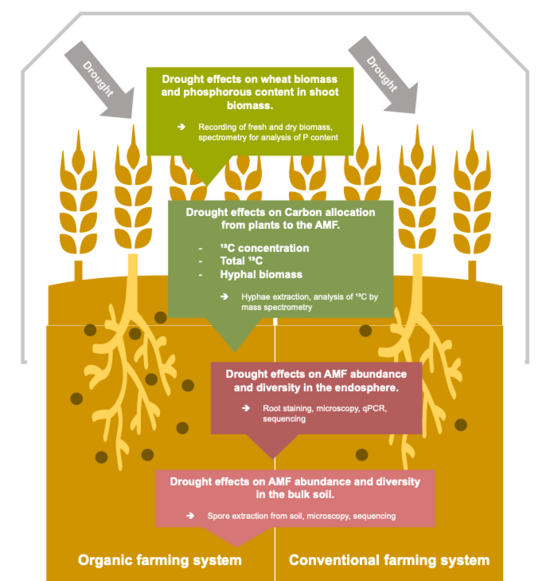
Drought effects on arbuscular mycorrhizal fungi functioning in the context of organic and conventional farming practices
MSc Nathalie Gräppi
12/2023
Supervision: Dr. Sarah Symanczik-Petris (FiBL), Dr. Dominika Kundel (FiBL) and Prof. Klaus Schlaeppi
Abstract:
Climate change and its effects have a significant impact on agriculture. Drought leads to an increased amount of crop failures and poses a threat for global food production. Plants live together with a variety of microorganisms. One particular group of microorganisms is the arbuscular mycorrhizal fungi, which supply plants with important nutrients and water, making them more resistant to stress. However, there is still a lack of knowledge how drought stress affects the symbiosis between arbuscular mycorrhizal fungi and plants and what role different farming systems play in this. The aim of this work is to gain insights into the effects of drought stress on arbuscular mycorrhizal fungi abundance, functionality and community in biodynamic and conventional farming systems. According to this, we formulated the following hypotheses: (i) We expect higher wheat yields and phosphorous uptake in conventional compared to biodynamic farming systems. (ii) In addition, we assume that the experimental drought decreases wheat yield and nutrient uptake and that this effect is more pronounced in conventional farming systems than in the biodynamic farming system. (iii) We expect that under drought wheat invests more in the arbuscular mycorrhizal symbiosis leading to an increase in 13Carbon in arbuscular mycorrhizal fungi hyphae. (iv) Based on contrasting physio-chemical and biological soil characteristics, resulting from different soil management practices, we expect to find a higher abundance and more diverse arbuscular mycorrhizal fungi communities in the biodynamic compared with the conventional farming systems. (v) We expect that the experimental drought enhances arbuscular mycorrhizal fungi abundance but decreases diversity especially under conventional management.
To answer these hypotheses, a number of classical methods were used, such as the extraction of spores from soil by sucrose density gradient centrifugation or arbuscular mycorrhizal fungi quantification by root staining. In addition, molecular methods were used to gain insights into the frequency and diversity of arbuscular mycorrhizal fungi. Furthermore, plants were regularly labelled with ¹³CO₂ to determine carbon allocation under drought stress. In addition, data on wheat biomass and phosphorous content of shoot biomass were collected and analyzed to determine the effects of drought stress and the different farming systems on the symbiosis with plants. In addition, the soil moisture content in the different plots was measured throughout the experiment to investigate the effects of the simulated drought. Although soil moisture content was still relatively high at the beginning of the experiment, it decreased in the warmer months of the season, resulting in hardly any difference in soil moisture content between the different plots. Regarding the measured plant parameters, we could not detect any influence of the farming system on the biomass or the phosphorous content of the plants, but drought led to a reduced dry biomass as well as to a reduced fresh biomass, which was particularly pronounced in the conventional farming systems. In addition, drought led to a reduction in phosphorous content in winter wheat in all farming systems. Although no effects of drought were observed in terms of ¹³Carbon concentration, significant effects of drought on total ¹³Carbon amount and hyphal biomass were found. Since neither the classical root staining method nor qPCR worked, no statements can be made about the abundance of arbuscular mycorrhizal fungi in the roots. In addition, no significant effects of drought stress on spore abundance could be detected. Likewise, no statements can be made about the diversity of arbuscular mycorrhizal fungi in the soil and in the roots of wheat, due to the lack of arbuscular mycorrhizal fungi reads that made a statistical evaluation impossible. However, it was possible to gain insights into the general fungal diversity in the bulk soil and in the endosphere. Drought stress led to reduced α-diversity in the endosphere and altered β-diversity in the bulk soil and in the endosphere. While no effects of the farming system on α-diversity could be detected, the farming system had an impact on β-diversity in the bulk soil and in the endosphere.
In summary, we were able to observe several effects of drought in our drought stress experiment. However, these effects were mainly limited to plant parameters. No effects of drought stress or farming system on arbuscular mycorrhizal fungi abundance and diversity were observed. A possible reason for this could be that the wheat variety Wiwa was generally low colonized due to the general drought in 2023. In addition, the differences in soil moisture content between the plots were very small, making it difficult to observe treatment or system effects on arbuscular mycorrhizal fungi abundance and diversity.
Quick Links
Social Media
